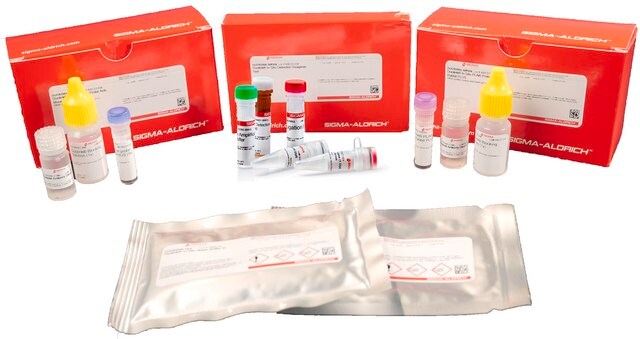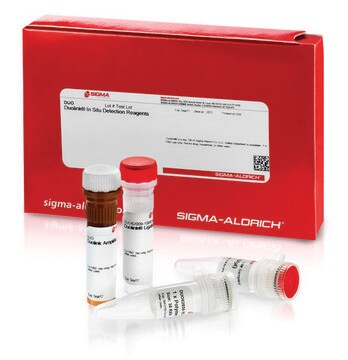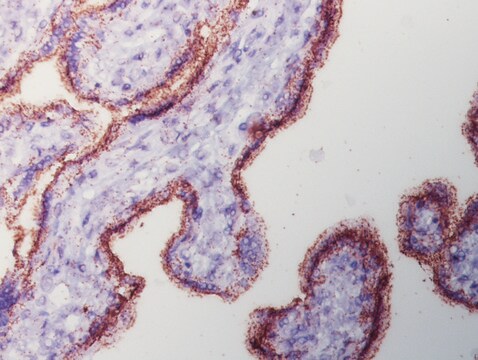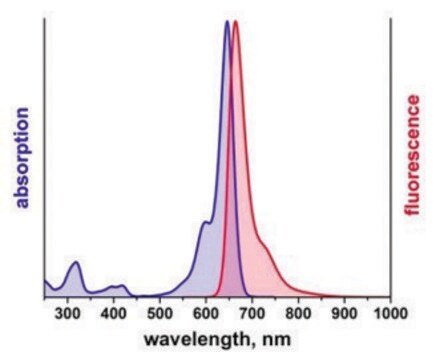DUO92006
Duolink® In Situ PLA® Probe Anti-Goat MINUS
Affinity purified Donkey anti-Goat IgG (H+L)
Synonym(e):
in situ Proximity Ligation Assay Kit, Protein Protein Interaction Kit
About This Item
Empfohlene Produkte
Biologische Quelle
donkey (polyclonal)
Qualitätsniveau
Antikörperform
affinity purified immunoglobulin (secondary antibody)
Antikörper-Produkttyp
primary antibodies
Produktlinie
Duolink®
Speziesreaktivität
goat
Methode(n)
immunofluorescence: suitable
proximity ligation assay: suitable
Eignung
suitable for brightfield
suitable for fluorescence
Versandbedingung
wet ice
Lagertemp.
2-8°C
Verwandte Kategorien
Anwendung
This product can be applied to both the Duolink® In Situ Fluorescence Protocol and the Duolink® In Situ Brightfield Protocol depending on the detection reagents used.
Visit our Duolink® PLA Resource Center for information on how to run a Duolink® experiment, applications, troubleshooting, and more.
To perform a complete Duolink® PLA in situ experiment you will need two primary antibodies (PLA, IHC, ICC or IF validated) that recognize two target epitopes. Other necessary reagents include a pair of PLA probes from different species (one PLUS and one MINUS), detection reagents, wash buffers, and mounting medium. Note that the primary antibodies must come from the same species as the Duolink® PLA probes. Analysis is carried out using standard immunofluorescence assay equipment.HRP is also available for brightfield detection.
PLA probe anti-Goat reacts with whole molecule goat IgG and the light chains of other goat immunoglobulin?s. The PLA probe anti-Goat may cross-react with sheep antibodies, but has minimal cross reactivity with chicken, guinea pig, Syrian hamster, horse, human, mouse,rabbit, and rat serum proteins. A PLUS probe of a different species must be used simultaneously with this product. See our Product Selection Guide for more information.
Application Note
Two primary antibodies raised in different species are needed. Test your primary antibodies (IgG-class, mono- or polyclonal) in a standard immunofluorescence (IF), immunohistochemistry (IHC) or immunocytochemistry (ICC) assay to determine the optimal fixation, blocking, and titer conditions. Duolink®PLA in situ reagents are suitable for use on fixed cells, cytospin cells, cells grown on slide, formalin-fixed, paraffin embedded (FFPE), or tissue (fresh or frozen). No minimum number of cells is required.
Let us do the work for you, learn more about our Custom Service Program to accelerate your Duolink® projects
View full Duolink® product list
Leistungsmerkmale und Vorteile
- No overexpression or genetic manipulation required
- High specificity (fewer false positives)
- Single molecule sensitivity due to rolling circle amplification
- Relative quantification possible
- No special equipment needed
- Quicker and simpler than FRET
- Increased accuracy compared to co-IP
- Publication-ready results
Komponenten
- 5x PLA Probe Anti-Goat MINUS - Donkey anti-goat secondary antibody conjugated to oligonucleotide MINUS
- 1x Blocking Solution - Reagent for blocking of the sample
- 1x Antibody Diluent - For dilution of PLA probes and primary antibodies
Rechtliche Hinweise
Sie haben nicht das passende Produkt gefunden?
Probieren Sie unser Produkt-Auswahlhilfe. aus.
Lagerklassenschlüssel
10 - Combustible liquids
Analysenzertifikate (COA)
Suchen Sie nach Analysenzertifikate (COA), indem Sie die Lot-/Chargennummer des Produkts eingeben. Lot- und Chargennummern sind auf dem Produktetikett hinter den Wörtern ‘Lot’ oder ‘Batch’ (Lot oder Charge) zu finden.
Besitzen Sie dieses Produkt bereits?
In der Dokumentenbibliothek finden Sie die Dokumentation zu den Produkten, die Sie kürzlich erworben haben.
Kunden haben sich ebenfalls angesehen
Artikel
Find Duolink references based on the type of method used, post translational modification detected, and research focus.
Things to consider for preparation, setup and execution of the Duolink® assay protocol
Support information including tips and tricks, frequently asked questions, and basic troubleshooting.
Protokolle
This protocol describes the use of Duolink® PLA reagents for the brightfield detection, visualization, and quantification of individual proteins, protein modifications, and protein interactions in tissue and cell samples.
Protocol for use of Duolink® PLA reagents for the detection of individual proteins, protein modifications, and protein-protein interactions within cell populations by flow cytometry.
Unser Team von Wissenschaftlern verfügt über Erfahrung in allen Forschungsbereichen einschließlich Life Science, Materialwissenschaften, chemischer Synthese, Chromatographie, Analytik und vielen mehr..
Setzen Sie sich mit dem technischen Dienst in Verbindung.









